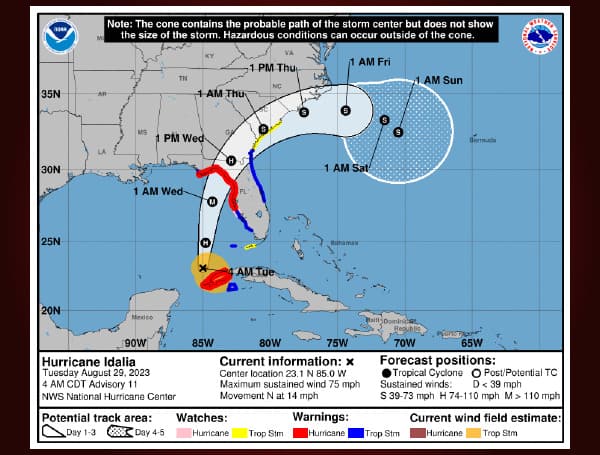Tropical Storm Idalia intensified and became a hurricane on Tuesday. This intensification indicated a significant increase in its wind speeds and overall strength.
The hurricane is projected to have sustained winds of up to 120 mph (193 kph) as it approaches Florida. If it reaches this intensity, it would classify as a Category 3 hurricane on the Saffir-Simpson Hurricane Wind Scale.
At 5 a.m. Tuesday, Idalia was located about 85 miles north of the western tip of Cuba. The system had sustained winds of 75 miles an hour with higher gusts and was moving to the north at 14 miles per hour.
In the news: Florida Gov. DeSantis: Be ‘Vigilant’ As Idalia Threatens
“You should be wrapping up your preparation for #TropicalStormIdalia tonight and Tues morning at the latest,” the National Weather Service in Tampa Bay said Monday on X, formerly known as Twitter.
Path Toward Florida’s Gulf Coast: Idalia’s path is directed toward Florida’s Gulf coast. The National Hurricane Center issued warnings about the increasing risk of life-threatening storm surge and dangerous hurricane-force winds for the Florida region over the next two days.
Projected Strength: The hurricane is projected to have sustained winds of up to 120 mph (193 kph) as it approaches Florida. If it reaches this intensity, it would classify as a Category 3 hurricane on the Saffir-Simpson Hurricane Wind Scale.
Anticipated Landfall: The center of Hurricane Idalia is forecasted to move over the eastern Gulf of Mexico on Tuesday, reach the Gulf coast of Florida within the Hurricane Warning area on Wednesday, and potentially move close to the Carolina coastline on Thursday.
Preparations and Evacuations: Florida residents are taking precautions in response to the intensifying hurricane. Sandbags are being used to mitigate flooding risks, and residents in low-lying areas along the Gulf Coast are evacuating their homes in anticipation of the storm’s impact.
Potential Storm Surges: The forecast indicates the possibility of life-threatening storm surges, which occur when strong winds push seawater onto the land, causing flooding and posing significant dangers to coastal communities.
In the news: Florida Schools, Colleges Shutter In Advance Of Idalia
Impact on Florida: The prediction that Idalia will reach Florida’s Gulf coast as a major hurricane underscores the potential for significant impacts, including strong winds, heavy rainfall, and storm surges.
As with any hurricane, it’s crucial for residents in the affected areas to closely follow updates from official sources, heed evacuation orders if necessary, and take all recommended safety precautions. Authorities and emergency management agencies provide guidance to ensure the safety of individuals and communities in the path of the storm.
Hurricane Warning:
- Cuban province of Pinar del Rio
- Middle of Longboat Key northward to the Indian Pass, including Tampa Bay
Storm Surge Warning:
- Englewood northward to the Indian Pass, including Tampa Bay
Tropical Storm Warning:
- Isle of Youth Cuba
- Dry Tortugas Florida
- Chokoloskee northward to the Middle of Longboat Key
- West of Indian Pass to Mexico Beach
- Sebastian Inlet, Florida to Altamaha Sound, Georgia
Hurricane Watch:
- Englewood to the Middle of Longboat Key
Tropical Storm Watch:
- Lower Florida Keys west of the west end of the Seven Mile Bridge
- Sebastian Inlet Florida northward to Altamaha Sound Georgia
Storm Surge Watch:
- Chokoloskee northward to Englewood, including Charlotte Harbour
- Mouth of the St. Mary’s River to Altamaha Sound Georgia
Android Users, Click To Download The Free Press App And Never Miss A Story. Follow Us On Facebook and Twitter. Signup for our free newsletter.
We can’t do this without your help; visit our GiveSendGo page and donate any dollar amount; every penny helps

